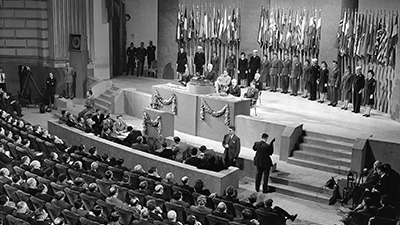Institutions Developing in a Globalized World
Driving Question: In what ways have global issues such as climate change, human rights, and security challenges required international cooperation?
After World War II, many countries came together to create international institutions like the United Nations, with the goals of maintaining peace and encouraging international cooperation. In this era of intense globalization, how have the aims of these institutions and international interactions between nations changed?
Learning Objectives
- Explain how and why globalization changed international interactions between states.
- Analyze the continuities and changes that have taken place in the global economy since World War II.
Vocab Terms:
- economic liberalization
- environment
- humanitarian
- liberalize
- non-governmental organization
- regulation
- socioeconomic
Opener: Institutions Developing in a Globalized World
To teach this lesson step, refer to page 2 of the Lesson 9.8 Teaching Guide.
Assessing continuity and change over time can help you understand how globalization has impacted our lives.
International Institutions
To teach this lesson step, refer to page 3 of the Lesson 9.8 Teaching Guide.
From the United Nations, to the International Monetary Fund and World Bank, a variety of international institutions emerged after World War II in an attempt to solve world problems without the need for another global conflict. This article explores the history of these institutions, as well as how they operate today.
-
Guiding Questions
-
Before you read
Preview the questions below, and then skim the article. Be sure to look at the section headings and any images.
While you read
Look for answers to these questions:
- What is an “institution,” and why did leaders want to create them on a global scale after WWII?
- Why was the United Nations created, and what does it do?
- What were the two crucial economic institutions that formed after 1945, and what were their original goals?
- What is “economic liberalization,” and how does it differ from the original goals of global economic institutions?
- How do non-governmental institutions promote change on a global level?
- What are some of the positive and negative impacts global institutions have had on societies and human communities?
After you read
Respond to the following questions:
- The distinction between political, economic, and non-governmental institutions “isn’t always very neat.” What are some of the ways these institutions overlap?
- How have international institutions changed our world? Do you think these differences are the same everywhere, or do they vary across communities? Why might this be?
CCOT: Unit Comparisons
Solving a mystery: While globalization in the late twentieth century may have provided a great wealth boost overall, it didn’t address the deepening inequality across and within societies. Have students brainstorm why inequality may have worsened.
- Students can suggest their own ideas.
- They can prompt AI for additional thoughts.
- Together, they determine what evidence would support or refute each argument.
- Finally, groups research each claim and report findings, and then the class debriefs.
What’s the rationale? This inquiry-based approach casts students as investigators. AI becomes a brainstorming partner rather than the final word, helping students probe complex questions using evidence and critical thinking.
It’s time to put it all together in this final CCOT activity. Using what you’ve learned in this course about history since 1200 CE to present, craft an essay identifying the most significant changes and continuities in this long time period.
Closer: Institutions Developing in a Globalized World
To teach this lesson step, refer to page 8 of the Lesson 9.8 Teaching Guide.
Closers are a great way to assess student learning, and the Unit 9 Themes Notebook is a perfect way to see progress. Read more in the OER Project Assessment Guide.
You’re an expert on the AP themes and globalization at this point in the course. See how much you’ve learned since the beginning of the unit.




